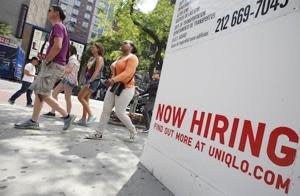 The Lookout
The LookoutJune jobs numbers expected to show improvement

With the government set to release its June jobs report tomorrow morning, most experts are forecasting a solid improvement from May's dismal performance--but they don't expect to see the kind of numbers that would quickly put a dent in the sky-high jobless rate.
Economists surveyed by Reuters predicted that tomorrow's report would show that employers added round 90,000 jobs in June. If that forecast is borne out, it would double May's measly 54,000 total.
But that survey came before the release this morning of a report by the payroll processor ADP, which found that private employers added 157,000 jobs last month--far more than the 68,000 economists had predicted for June.
The upward adjustment in the jobs forecast also preceded a separate Labor Department report finding that first-time claims for jobless benefits dropped last week by 14,000, to 418,000.
Those pieces of positive news--especially the ADP report--prompted some economists to raise their predictions for what tomorrow's official number will be. The official government jobs tally includes both private- and public-sector jobs.
The better data--which also include news that manufacturing expanded in June at a faster pace than in May--suggest that May's paltry jobs picture may have been caused largely by temporary factors, such as supply-chain problems stemming from the Japanese earthquake and tsunami and rising food and gas prices.
Still, the recovery figures to proceed at a slow pace.
"The soft patch will prove to be a temporary one, but that doesn't mean we'll be roaring ahead with growth," David Resler, an economist with Nomura Securities International told Reuters.
The first quarter of 2010 saw GDP growth of just 1.8 percent, and predictions for second-quarter output aren't much higher. Most forecasts see healthier growth of around 3-3.5 percent in the second half of the year.
But that still would likely produce only enough job gains to keep pace with the growth in the labor market. To significantly lower the jobless rate--currently at 9.1 percent--the economy would need to start growing at a rate of around 5 percent, they say. And that's a long way from happening.
